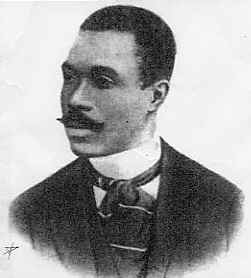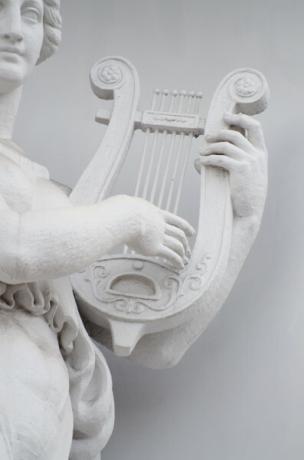Cruz e Sousa, black poet from Santa Catarina, is registered in the history of Brazilian literature as the most important poet of the simbolism. Son of enslaved black parents, he was sponsored as a child by the slave master, receiving, as godson, a formal erudite education, which allowed him access to the best of the literature of his time.
Despite being an intellectual equal to any other, his condition as a black man imposed on him the racial prejudice throughout your life. Attentive to the reality that surrounded him, he became an active abolitionist, author of poems and prose texts against slavery.
Read too: Maria Firmina dos Reis – abolitionist writer of Brazilian romanticism

Cruz e Sousa's Biography
João da Cruz e Sousa, known in the literary world as Cruz e Sousa, born on November 21, 1861, in the then city of Desterro, now known as Florianópolis, capital of Santa Catarina.
His parents were the master mason Guilherme da Cruz and the laundress Carolina Eva da Conceição, both enslaved blacks and freed. Cruz e Sousa received, as usual in slave society, the surname and protection of the slave master who sponsored him, Colonel Xavier de Sousa, receiving formal education, while his parents continued to live a life of subjugation.
At eight years old, Cruz e Sousa startor your taste for poetry, on which he declaimed verses of his own, which honored the return of Colonel Xavier de Sousa da Paraguay War.
Between 1871 and 1875, the young poet attended, with a scholarship, the Ateneu Provincial Catarinense, elite educational establishment. He had as a professor of natural sciences the German naturalist Fritz Muller, friend and collaborator of Darwin. Very intelligent, Cruz e Sousa excelled in mathematics and foreign languages such as French, English, Latin and Greek.
In addition to these areas of knowledge, the poet was a voracious reader of writers such as Baudelaire, Leopardi, Antero de Quental, Guerra Junqueiro, among other contemporary European authors. That immense cultural baggage, however, did not deprive him of being a victim of racism, in a highly slavery context.
In 1881, he traveled from Porto Alegre to São Luís, in the exercise of the function of secretary of the Julieta dos Santos Dramatic Company. This trip enabled him to broaden his horizons about the conditions in which blacks were kept in the final years of slavery.
Shortly thereafter, Cruz e Sousa engaged in the abolitionist campaign and, in Bahia, delivered a speech, with a poem of his in honor of Castro Alves being transcribed in the local newspaper.
Do not stop now... There's more after the advertising ;)
The poet thus inserted himself at once into literary life, founding, with Virgílio Várzea and Santos Losada, in Santa Catarina, the weekly newspaper Columbus, literary periodical Parnassian. He also participated in the Ideia Nova group, and, in 1885, he published, with Virgílio Várzea, the book Tropes and costumes, a work in which abolitionist texts are found. He directed the illustrated newspaper The boy, heavily discriminated by local social circles due to its critical bias. Collaborated in the republican and abolitionist newspaper People's Tribune, considered the most illustrious newspaper in Santa Catarina of the period.
In 1890, he moved to Rio de Janeiro, where he collaborated with several media outlets, in which he published articles-manifesto of the symbolism. He lived intellectually with Raul Pompeia and with olavo bilac. In 1893 he released one of his major books, the work of poems in prose Missal, and Drills, book of poems.
He married the young black woman Gavita Rosa Gonçalves, with whom he had four children. The family suffered several financial problems, due to the low salaries received in the modest posts he assumed. To make matters worse, his wife developed mental disorders after the birth of their second child.
Afflicted by tuberculosis, moved inland to improve his health. However, the disease has not stabilized, and the poet died on March 19, 1898, at 36 years of age.
Literary Characteristics of Cruz e Sousa
→ Shape
Preference for sonnet;
Composition of other forms of poem less rigid than the sonnet.
→ Language
Subjective;
Vague and imprecise, with a predominance of suggestions rather than objective nominations;
Predominance of nouns abstracts;
Predominance of adjectives;
Frequent use of speech figures, as metaphor, comparison, alliteration, assonance and synesthesia.
→ Content
Themes linked to mysticism and religiosity;
Expression of contemplative mental states;
Predominance of a pessimistic tone, which expresses the existential pain of the me lyric;
Interest in themes linked to mystery, at night, to death;
Predominance of an anti-rationalist and anti-materialist worldview, which resembles the romanticism.
See more: Francisca Júlia – Parnassian writer who had a good reception in her time
Works by Cruz e Sousa
Buckets (1893) – poetry
Missal (1893) – prose poems
Tropes and costumes (1885) – poems in prose (partnership with Virgílio Várzea)
→ Posthumous works
latest sonnets (1905)
Evocations (1898) – prose poems
headlights (1900) - poetry
other evocations (1961) – prose poems
the ultimate book (1961) - poetry
scattered (1961) – prose poems
Cruz e Sousa poems
prison of souls
Ah, Every soul in a prison is imprisoned,
sobbing in the darkness between the bars
From the dungeon looking at immensity,
Seas, stars, afternoons, nature.
Everything wears an equal grandeur
When the soul in shackles the freedoms
Dreams and, dreaming, immortalities
It tears in the ethereal Space of Purity.
O trapped, mute and closed souls
In colossal and abandoned prisons,
Of the Pain in the dungeon, atrocious, funereal!
In these lonely, serious silences,
What keyring of Heaven holds the keys
To open the doors of the Mystery for you?!
(complete poetry)
In that poem, Cruz e Sousa expresses the main formal and thematic aspects that characterized the symbolism, such as the human suffering, which is manifested, throughout the verses, through the opposition between body and soul, in which the soul is only freed when the chains that imprison it to the corporeal matter are broken.
In addition to this metaphysical (in other words, beyond the physical) and spiritual tone, there is in the poem, as a very striking feature of Symbolist aesthetics, the constant presence of metaphors, which means that there are many suggestions and non-explanations of the messages conveyed by the lyrical self. For example, at no point in the poem is the word death explicitly mentioned, but it is inferred that the breaking of the chains refers to the loss of life and, consequently, to the liberation of the soul.
Another symbolist feature present in the poem, in addition to the presence of metaphors, concerns the use of synesthesia, figure of speech characterized by the junction of sensory aspects, as noted in this verse: “O trapped, mute souls”. Regarding formal aspects, Cruz e Sousa also expresses a symbolist tendency: the construction of sonnets, a form consecrated by classical literature.
carnal and mystical
Through the thinnest regions of the mist
wander the Virgins and the rare Stars...
Like the light aroma of the corns
the entire horizon around perfumes.
In an evaporation of white foam
the clear perspectives are diluting...
With raw and radiant tiaras shines
the Stars go out one by one.
And then, in the darkness, in mystical numbness,
parades, with side-effects,
of the Virgins the sleepwalker procession...
O vague forms, nebulosities!
Essence of eternal virginities!
O intense chimeras of Desire...
(Buckets)
In this poem, Cruz e Sousa explores, in the first stanza, another recurrent feature in Symbolist literature: the use of alliteratedog, intentional repetition of consonant words. In the first stanza, for example, the use of the consonant v is observed in the words “vagam”, “Virgens”, present in the second verse, and in the word “light”, present in the third verse.
Another symbolist characteristic manifests itself in the use of abstract nouns ("aromas", "evaporation", "glows", "shapes", "essence", "chimeras") and adjectives ("rare", "clear", "raw", "sidereal", "sleepwalking", "vague", "eternal"), which contributes to the suggestive and abstract mood that runs through the entire poem.
By Leandro Guimarães
Literature teacher

